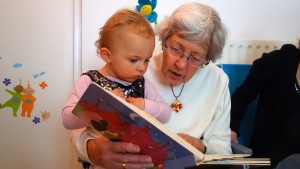Read It Again, Please
Does your child ask you to read the same book over and over and OVER? That’s a good thing. You are creating a love for reading. Your child will see himself/herself as a reader. As you read the same book over and over, your child will soon be able to “read” that book as well. “They’ve memorized it,” you will say. Yes, to a point, but actually they have internalized what it means to be a reader, to tell a story, to understand something from the printed page, and to enjoy reading.
When you read to a child, you are teaching them to read. How? Without saying a word, you are demonstrating “how it’s done.” You begin at the front. You turn one page at a time. You look at the pictures. You talk about the pictures. You read the words. You point to the words in simple books. “Well, duh!” you may say, but these are things that do not come naturally. These are things that must be taught and are taught best by demonstrating to a child on our lap. The teaching must be natural so that it is enjoyed, nonetheless it is teaching. Just as children playing kitchen or cars copy what they see adults do, so children learning to read will copy what they see you do. Read to your child and you will see them read to a sibling, a stuffed toy, a pet, and even you.
What if the words aren’t right? Your child can’t yet read words, but ask yourself if they have a sense of story. Is the story they are “reading” matching the pictures? If the story has a repetitive line such as “but he was still hungry” (The Very Hungry Caterpillar, by Eric Carle) and your child says “but I’m hungry.” you might point and read, “but he was still hungry.” Your child will pick up the repetition without you doing more than simply rereading the line. Rereading the line is another important skill good readers must be taught. If a sentence we read doesn’t make sense, don’t we go back and reread the line, correcting ourselves so the sentence makes sense?
What if my child is only using pictures? Pictures are an important part of comprehension for beginning readers. A child who isn’t using the pictures, likely isn’t comprehending the story. Many children “read” and miss the meaning because they don’t use the pictures to match their words. Their ability to read has not yet grown enough to simply read without pictures. Pictures are a self-checking method for beginning readers. If a child says dog, but the picture is a pig, the child who uses pictures can self-correct. The child who simply reads words will not understand the story, though the sentence, “I see a dog.” makes just as much sense as a sentence that says, “I see a pig.” Praise your child’s use of pictures but also use your finger to point and read the words. Your child will soon follow your demonstration. Are they reading words yet? No, but that time will come as they begin to recognize their name and are old enough to understand words are made of letters and letters make sounds. Right now, you are fostering the love of reading that will encourage them to want to learn how writing works later. By the way drawing is a form of writing that should be encouraged in children this age as well.
When should I start? As soon as your child is born, maybe even in the womb because an unborn child can hear your voice. To the very young, sing songs, read nursery rhymes, use one-word picture books of familiar things like pets, farm animals, toys, bugs, etc, but also include short stories. How long should I read? How long before your child gets the wiggles, two minutes, five minutes, ten minutes? It depends on the age and interest of the child. Let the child tell you by the wiggles when they have snuggled and read enough. Then tomorrow when your child brings you the same book for the tenth time, READ IT AGAIN!


Gail, thank you for your insightful post. You are right about reading even to an unborn child. Latest research studies show that children in the womb can, indeed, hear the voices of those near them.
What a precious gift to give to a precious child even before he or she is born!
Blessings,
MaryAnn
Thanks MaryAnn. Glad you enjoyed the post!
You are welcome, Gail! 🙂